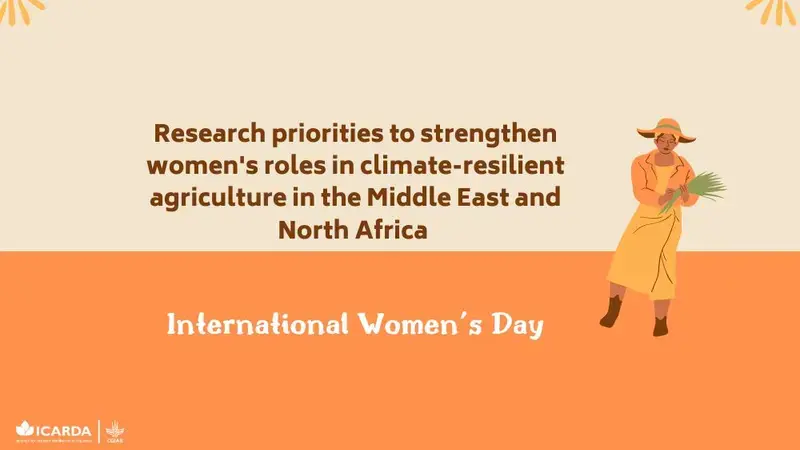Research priorities to strengthen women's roles in climate-resilient agriculture in the Middle East and North Africa

This work was part of the CGIAR Gender Platform and the CGIAR Initiative on Fragility to Resilience in Central and West Asia and North Africa.
A groundbreaking new research strategy identifies priorities to advance gender equality in agriculture in the Middle East and North Africa (MENA) region for adapting and building resilience to climate change.
The newly published strategy results from compiling over two decades of research in gender equality evidence and knowledge, outlining gaps in existing theoretical and applied assessment literature. The strategy aims to deliver recommendations for future research and public policy that can lead to significantly more equitable outcomes for women working in agriculture in the region and improved livelihoods and food security.
The MENA region is one of the most gender-unequal regions in the world*. Yet as more men follow a migration trend to urban areas, women are left behind to continue the viability of the family farm. The result is that over 50% of agricultural workers in the region are women. Yet, they are disadvantaged in agriculture because of entrenched gender roles and responsibilities, restrictive sociocultural norms, and lower access to productive resources, technology, markets, finance, and information. Even research outcomes, such as new crop varieties, favor traditional male users and their needs.
To address these constraints, the new strategy recommends specific target areas for research and action:
-
Collecting and analyzing gender-disaggregated data on women's formal and informal agricultural participation.
-
Enabling women to gain legal and social recognition as farmers.
-
Reforming male-biased inheritance practices and improving access to land ownership — taking into account that research in other regions, including in the MENA region, hints that legal measures alone are not enough. Social recognition of women's roles as farmers is also necessary.
-
Understanding women's ownership of non-land assets, such as livestock, agricultural equipment, investments, jewelry, cellphones, or computers, to optimize participation in agriculture.
-
Improving women's access to irrigation technologies and participation in water governance.
-
Identifying opportunities to introduce climate-resistant crops and hardier breeds of livestock as "greener" measures for drought mitigation and management.
-
Mechanizing responsibly so that wage workers, particularly women, are not displaced.
-
Protecting and empowering vulnerable farmers who rent land.
-
Optimizing women's incomes from complementary non-agricultural activities.
-
Identifying opportunities for women to organize and mobilize for rights, resources, and entitlements — based on the experience of existing cooperatives and producer groups in comparable regions like South Asia.
-
Understanding women's roles in rangeland cultivation and pastoral livelihoods.
-
Strengthening women's access to extension services and digital resources.
-
Reducing climate risk for farmers through insurance and green bonds.
-
Understanding the experiences and needs of refugees working in agriculture in the region.
-
Understanding how to make agricultural work more interesting for youth.
-
Assembling policy lessons relevant to the agricultural sector from the global COVID-19 experience.
The strategy also calls for policy interventions such as equal-pay legislation, strengthening social protection programs, increasing funding for agricultural extension services, building the capacity of local research institutions, and developing public awareness campaigns to highlight women's critical roles in agriculture.
Agriculture in the region is already highly vulnerable to the effects of climate change, both for crop and livestock farming. So if we overlook women's roles and contributions in agriculture, the ability of the MENA region to stay ahead of climate change impacts and global shocks will be seriously diminished.
* The MENA region is both extremely vulnerable to climate change and among the most gender unequal regions in the world. According to the Global Gender Gap report, the gender gap is highest in the MENA region (60.9 percent progress toward parity), and “at the current relative pace, it would take an estimated 142.4 years to close” (World Economic Forum, 2021: 26). The region performs well on health and education, with women and girls outperforming men and boys at all levels of education in some countries, but counterintuitively performs very poorly on economic and political participation: a phenomenon referred to as the “MENA paradox” (Kabeer, Deshpande and Assad, 2019).
--------
The strategy was researched and created by ICARDA's Dr. Dina Najjar and Dr. Bipasha Baruah of Western University, Canada, and published by ICARDA,
Read the research strategy:
Gender Equality, Climate Change, and Agriculture in the MENA region: Priorities and Possibilities
We would like to thank all funders who supported this research through their contributions to the CGIAR Trust Fund.
